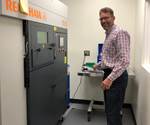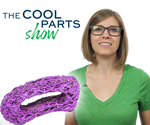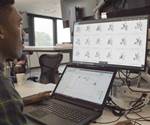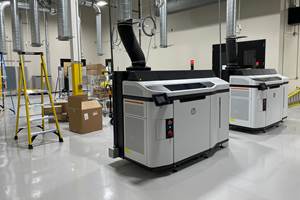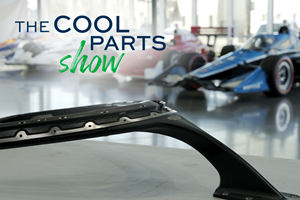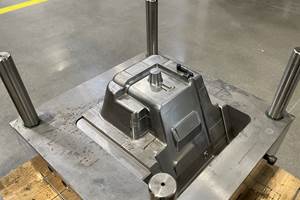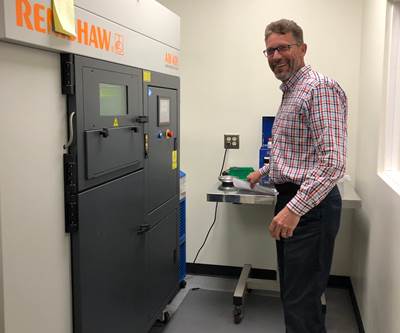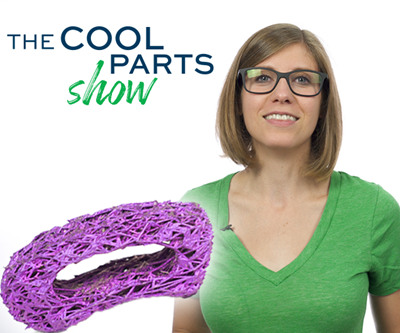3D Printing Changes a Drone Engine: The Cool Parts Show #9
Cobra Aero made the engine cylinder of an unmanned aerial vehicle (UAV) both more powerful and easier to manufacture. Learn what additive manufacturing is doing for drones in this episode of The Cool Parts Show.
For Cobra Aero, youth motorcycles and unmanned aerial vehicles (UAVs) have something in common: small engines. The company spawned from a competition motorcycle maker produces engines for UAVs used for research and military reconnaissance. But making the engine more powerful entailed using additive manufacturing (AM) in place of conventional manufacturing, and this started Cobra on a journey of reimagining the engine.
We follow that journey on this episode of The Cool Parts Show. Buying a metal AM system was a major step for this 35-employee company, but it enabled a radically different engine cylinder design achieved using software from nTopology. The company president describes how the investment in AM technology is paying off. | Season 2 of The Cool Parts Show brought to you by Carpenter Additive.
The Cool Parts Show is a video series from Additive Manufacturing Media that explores the what, how and why of unusual 3D printed parts. Watch more here.
Have a cool part to share? Email us.
Transcript
Peter Zelinski, Additive Manufacturing
We've got a small engine part that might look familiar, except you won't recognize it once you see how it's been reimagined for 3D printing. We talk about design for additive manufacturing on this episode of The Cool Parts Show.
Stephanie Hendrixson, Additive Manufacturing
Thanks to Carpenter Additive for sponsoring season two of The Cool Parts Show and for showing us around their Emerging Technology Center here in Athens, Alabama. Stick around at the end of the episode. We're going to talk about safety for metal AM. Now back to the show.
Peter Zelinski
I'm Pete.
Stephanie Hendrixson
I'm Stephanie.
Peter Zelinski
We're with AdditiveManufacturing.Media.
Stephanie Hendrixson
And this is The Cool Parts Show.
Peter Zelinski
This is our show all about cool 3D printed parts. Cool parts made additively by manufacturers, maybe manufactures like you.
Stephanie Hendrixson
All right, Pete. We've got a whole selection of parts here on the table in front of us. What are we going to talk about today?
Peter Zelinski
We're going to talk about design for additive manufacturing. I say that term, what do you think of?
Stephanie Hendrixson
I think of this idea that if you're designing a part to be made additively, you're not just thinking about the form and the function. You have to also think about the things in the printing process, the orientation, the support structures, things like that. And if you are maybe going from a conventional process to an additive process, you are probably going to want to rethink that part and maybe kind of reimagine it even.
Peter Zelinski
So, yeah — reimagining the part for additive manufacturing, that's what I've got here. This is actually all the same part. All the same component re-imagined for additive manufacturing.
Stephanie Hendrixson
Let me stop you right there. Basics first. What is this that I'm looking at?
Peter Zelinski
This is the cylinder for a one-cylinder engine made by Cobra Aero. It is the engine for an unmanned aerial system. Think drones. A piston goes in here. It's the cylinder for an engine that powers an unmanned aircraft like maybe the military might use.
Stephanie Hendrixson
So just looking at this group of parts in front of me, I'm going to guess that this one is the original before 3D printing.
Peter Zelinski
Super good guess. You're right. What do you say that?
Stephanie Hendrixson
The surface finish looks smoother than the other two on the table. And also, I believe it's two parts. Is part consolidation the reason they went to 3D printing?
Peter Zelinski
Just part of the reason. The bigger reason is cooling. These fins provide for heat transfer. But the problem with this part is there's not enough of the fins. So this cylinder doesn't cool as effectively as it should. This part, you're right, it was not made additively. It was made from casting. It's molten metal that was poured into a mold. And casting, the casting mold, limited how close together the fins can be and so limited the number of fins. So here is the part produced through 3D printing. And you're right. They could just print it as one entire solid piece. It's still the same cylinder, still has the same insides. But you can see there's a lot more fins. Because 3D printing lets the fins get closer together. So this part solves the cooling problem and provides for the level of cooling that this engine needs.
Stephanie Hendrixson
OK. So you get away from casting, which means you get away from tooling and you get away from the limitations that the tooling imposes on your design. So moving to 3D printing allows for more fins closer together. OK. So what is the printing process that they're using to make this?
Peter Zelinski
Sure. It's selective laser melting on a machine from Renishaw. So basically a laser moves through a bed of powder metal. The laser melts the metal in its path and it solidifies layer by layer by layer to build this complicated form.
Stephanie Hendrixson
All right. So you said the name of the company is Cobra Aero. Tell me about them.
Peter Zelinski
They're interesting. The original company is Cobra Moto, leading producer of youth motocross bikes. And it turns out this application, military drones, it's the same challenge. How do you make a powerful small engine? Here is Sean Hilbert, who is the president of Cobra Aero, to say more about that.
Sean Hilbert, Cobra Aero
Historically, these engines have been hobby engines. So the payload systems on these aircraft really outpaced the engines themselves for many, many years and it was actually very counterproductive because those engines were not made for long term durable applications; they were made for hobby applications. And the bottom line is the military was losing a lot of very expensive payloads because the engines were conking out.
Stephanie Hendrixson
So there's three parts on the table. We've talked about two of them. And I'm getting the sense that this is not the final part.
Peter Zelinski
Right. So this part solved the cooling problem, but it created a manufacturing problem. Look at this. What do you see here?
Stephanie Hendrixson
OK. So there's a whole bunch of support structures on this side of the part holding up all of these fins, and I imagine that somebody has got to then manually clip all those off and clean up that part.
Peter Zelinski
That's right. While this part is being 3D printed, to support it while it's still incomplete, a design like this required all these external supports. This is wasted material and it took a lot of hand labor to remove it. So to solve the manufacturing problem, this is how they re-imagined the part. Again on the inside it's the same. It's still a cylinder. Now, the cooling fins have been replaced by, you can see, this lattice structure. The lattice structure is completely contained within this cowl and no support structures are needed. The part is complete. Pretty much ready to go as it comes out of additive manufacturing.
Stephanie Hendrixson
Yeah. So that's like a total re-imagining. They've completely abandoned this idea of having fins and the lattices are doing all of that cooling now.
Peter Zelinski
Yeah.
Stephanie Hendrixson
So how did they design this part?
Peter Zelinski
So you might know how they designed this part, at least the lattices. Do you remember The Cool Parts Show Season 1, Episode 2?
Stephanie Hendrixson
If I recall, that was our episode on spine implants.
Peter Zelinski
Right. Remember how they designed the topology optimized implants the software they used?
Stephanie Hendrixson
Yeah. From nTopology.
Peter Zelinski
That's right. So nTopology software: Cobra Aero used that to help them design these lattices.
Stephanie Hendrixson
The other thing that I remember about the spine implant episode is that the lattice was really crazy, like the struts were going every which way by comparison. This looks pretty simple.
Peter Zelinski
It is simple if you look at the outer surface here, but there are some things going on. The lattices geometrically follow this kind of organic shape of the cowl. And they also mate up with the cylinder form on the inside and there's no disconnect throughout there. And also internally, the form of the lattice changes to optimize the cooling effect. So this lattice pattern you see on the outside: It transitions into a different form on the inside.
Stephanie Hendrixson
OK. So there actually is some complexity to designing a lattice that's going to change through the course of the part and then to get it to kind of terminate on the edges.
Peter Zelinski
Right. There's design complexity to take advantage of the fact that additive manufacturing can produce complexity like that in a way that another process can't.
Stephanie Hendrixson
All right. So that seems like a pretty big stretch. We're pretty far past motocross bikes right now.
Peter Zelinski
Yeah, I guess so.
Stephanie Hendrixson
Is additive manufacturing used for more than cylinders?
Peter Zelinski
Yeah. And actually, it kind of had to be. Here's Sean Hilbert again, Cobra Aero, to talk about this, to talk about how they thought about additive manufacturing when they were first getting into it.
Sean Hilbert
I had a notion that when we first got this machine that we would be using it in ways and dreaming up things that we never would have thought of otherwise. In fact, when we first did the math on “Is this thing going to pay back,” we had to kind of fudge things a little bit to say, “You know what, we better be able to use this machine in ways that we never dreamed of or else it won't pay back for us.” And as it turns out, I think that calculation was way too conservative. We've been able to use it in ways that we never dreamed of to begin with. We're using it for tooling, we're using it for rapid iterations of prototypes, and we're using it for production work all at the same time. Probably the best opportunity that we saw that we didn't expect was the engine mounts on our A33 single-cylinder aircraft engine. We had competitors and we had customers that had their own mounts. And our notion early on was, well, either we'll buy this mount because that wasn't really core to our business or we'll just sell the engine without a mount to our customer and they've got their own mount. We looked at their mount designs and we realized that they were heavy, they were complex, they were bulky. So we said, here's an opportunity for us to rethink things a little bit. And as it turns out, we created a mount that isolates the engine from the fuselage much better. And as far as the weight goes, we were able to optimize the topology of it to the point where our lightest competitor’s mount is about 385 grams. And we came in at about 160.
Peter Zelinski
Yeah. So those engine mounts: Did you see those parts? Another example of parts reimagined for additive manufacturing. Those engine mounts are way lighter than the part used to be, but first they had to conceive of a form of it that is easy to make through additive manufacturing, but would be way different from how that part would look if you made it in the other way.
Stephanie Hendrixson
Yeah. So it sounds like Cobra is really kind of embracing this idea of design for additive manufacturing. It's not just about the function, but also how you're going to make the part.
Peter Zelinski
Yeah.
Stephanie Hendrixson OK. So I think I got this. This is a 3D printed cylinder for a drone engine. It's a part that used to be made in two different pieces, with the casting process moving to 3D printing allowing them to consolidate that part. So then they transition to a totally different design using lattices as the cooling mechanism. And as a result, this part functions better and it's also a lot easier to manufacture. The post-processing is really minimal now.
Peter Zelinski
Yeah. Nailed it. So that's our episode. Thank you for watching The Cool Parts Show.
Stephanie Hendrixson
If you're making a cool part, you want to tell us about it. Email us. CoolParts@AdditiveManufacturing.Media.
Peter Zelinski
Don't forget to subscribe.
Begin sponsored content
Stephanie Hendrixson
I'm here in the gowning area at Carpenter Additive's Emerging Technology Center in Athens, Alabama. This is a contract production facility that's set up to handle everything from concept to creation, taking metal powder and turning it into 3D printed parts. There are some dangers involved in the metal powder bed fusion process. For the technology that's used here, personal protective equipment or PPE like safety glasses and respirators can help to protect individual operators. But facility-wide systems and procedures are the best way to prevent a problem.
Peter Bocchini, Carpenter Additive
Obviously with metal powder additive manufacturing, there's some inherent hazards. The first is that metal powder can be flammable or combustible. It's really important that you keep any static discharge out of the manufacturing floor. We have electrostatic dissipative flooring. We also require all of our employees to wear special safety shoes that are also static dissipated. We have dedicated special rooms for powder handling and those rooms are used anytime there's a lot of open powder. There's a full face mask that you have to wear. There are different suits you have to wear. By containing the bulk of the powder handling to these specific rooms, we limit the amount of exposure there is to the general shop floor.
Related Content
What Does Additive Manufacturing Readiness Look Like?
The promise of distributed manufacturing is alluring, but to get there AM first needs to master scale production. GKN Additive’s Michigan facility illustrates what the journey might look like.
Read MoreThis 3D Printed Part Makes IndyCar Racing Safer: The Cool Parts Show #67
The top frame is a newer addition to Indycar vehicles, but one that has dramatically improved the safety of the sport. We look at the original component and its next generation in this episode of The Cool Parts Show.
Read More8 Cool Parts From Formnext 2024: The Cool Parts Show #78
End-use parts found at Formnext this year address various aspects of additive's advance, notably AM winning on cost against established processes.
Read MoreDaimler, OMIC Evaluate Wire-Fed DED for Moldmaking
3D printing a core and cavity on machine from Gefertec, followed by machining, allowed for a complete mold tool to be produced in three days.
Read MoreRead Next
Drone Engine Maker Illustrates How Additive Manufacturing Well Suited to OEMs
This small company making small engines sees big wins from metal AM in terms of both product performance and responsiveness to the market. Here, size isn’t a factor in succeeding with AM — the application instead shows how the capability is at its best when it can serve both production and design.
Read MoreTopology Optimized 3D Printed Spine Implant: The Cool Parts Show #2
Medical contract manufacturer Tangible Solutions shares a titanium 3D printed spine implant with an unusual lattice structure in this episode of The Cool Parts Show.
Read MoreAM Brings Down the Wall Between Manufacturing and Design
In additive manufacturing, design and manufacturing blend together. They can’t be separate if AM is to realize its promise.
Read More

